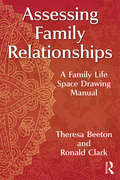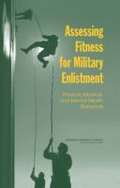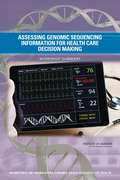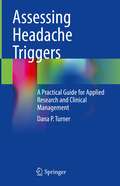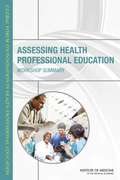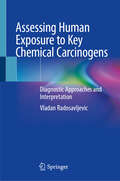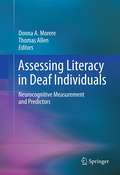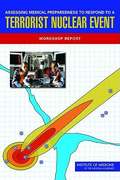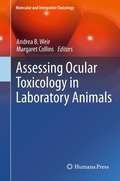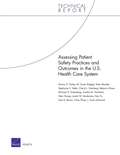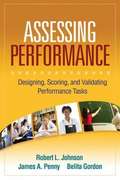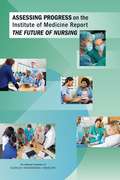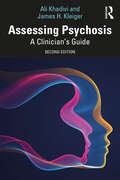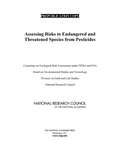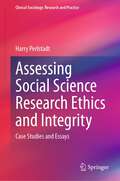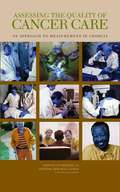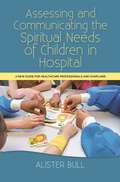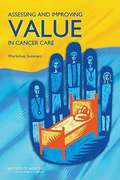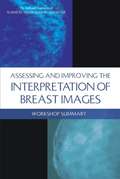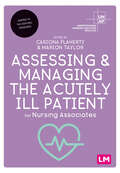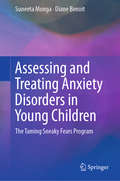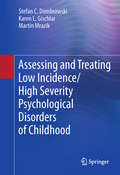- Table View
- List View
Assessing Evidence to Improve Population Health and Wellbeing (Transforming Public Health Practice Series)
by Carmen AceijasWritten to support practitioners undertaking a Masters in public health, this book considers the main concepts, issues and methodologies of the second core competence of the Public Health Skills and Career Framework: 'Assessment of evidence of the effectiveness of interventions, programmes and services to improve population health and wellbeing'. Coverage includes the theoretical definition of evidence and its use in public health, the role of critical appraisal methods and tools in evidence assessment and how Effectiveness, Efficiency and Quality inform evidence. The book is packed with case studies and activities to help link theory and practice and prompt personal reflection.
Assessing Family Relationships: A Family Life Space Drawing Manual
by Theresa A. Beeton Ronald A. ClarkAssessing Family Relationships shows mental health professionals how to utilize the Family Life Space Drawing (the FLSD), a family assessment tool that incorporates information from multiple family members while building connections between the clinician and the client. In this manual, Theresa A. Beeton and Ronald A. Clark demonstrate the usefulness of the FLSD in both family and couple counseling. As a task-centered assessment tool, the FLSD enables an interactive and personalized process of counseling, which helps individuals to express concerns and information about themselves in an indirect and nonthreatening manner. Chapters are illustrated throughout with case studies and drawings adapted from the authors’ own clinical experience, and the manual offers an overview of the history of the FLSD, as well as where future research is headed. Providing a practical explanation of how to complete the FLSD process, Assessing Family Relationships will be highly relevant to couple and family therapists, as well as clinical social workers, who are interested in updating their practice with innovative family assessment research and techniques.
Assessing Fitness for Military Enlistment: Physical, Medical, and Mental Health Standards
by National Research Council of the National AcademiesA report on Assessing Fitness for Military Enlistment.
Assessing Genomic Sequencing Information for Health Care Decision Making: Workshop Summary
by Sarah H. BeachyRapid advances in technology have lowered the cost of sequencing an individual's genome from the several billion dollars that it cost a decade ago to just a few thousand dollars today and have correspondingly greatly expanded the use of genomic information in medicine. Because of the lack of evidence available for assessing variants, evaluation bodies have made only a few recommendations for the use of genetic tests in health care. For example, organizations, such as the Evaluation of Genomic Applications in Practice and Prevention working group, have sought to set standards for the kinds of evaluations needed to make population-level health decisions. However, due to insufficient evidence, it has been challenging to recommend the use of a genetic test. An additional challenge to using large-scale sequencing in the clinic is that it may uncover "secondary," or "incidental," findings - genetic variants that have been associated with a disease but that are not necessarily related to the conditions that led to the decision to use genomic testing. Furthermore, as more genetic variants are associated with diseases, new information becomes available about genomic tests performed previously, which raises issues about how and whether to return this information to physicians and patients and also about who is responsible for the information. To help develop a better understanding of how genomic information is used for healthcare decision making, the Roundtable on Translating Genomic-Based Research for Health of the Institute of Medicine held a workshop in Washington, DC in February 2014. Stakeholders, including clinicians, researchers, patients, and government officials, discussed the issues related to the use of genomic information in medical practice. "Assessing Genomic Sequencing Information for Health Care Decision Making" is the summary of that workshop. This report compares and contrasts evidence evaluation processes for different clinical indications and discusses key challenges in the evidence evaluation process.
Assessing Headache Triggers: A Practical Guide for Applied Research and Clinical Management
by Dana P. TurnerThis book synthesizes the current research on headache triggers and details how improving the measurement properties of trigger assessments can benefit clinical and research efforts. The book begins with a detailed exploration of the history of triggers and their use in attempts to assign causes to headache attacks. Subsequent chapters then expound on the existing schools of thought on headache triggers with discussions of understudied influences on the causal assignment process, such as the role of individual trigger beliefs and perceptions. After laying this groundwork, the practical application of trigger assessment is thoroughly detailed, including assessment design types and methods of analysis. Chapters then outline the applications of trigger assessment in research and clinical practice. To conclude, the book relays descriptions of future directions and evolving theories in the area.Concise and comprehensive, Assessing Headache Triggers is an invaluable resource for clinicians who treat patients and investigators who aim to improve the lives of individuals with headache through their research.
Assessing Health Professional Education: Workshop Summary
by Patricia A. Cuff"Assessing Health Professional Education" is the summary of a workshop hosted by the Institute of Medicine's Global Forum on Innovation in Health Professional Education to explore assessment of health professional education. At the event, Forum members shared personal experiences and learned from patients, students, educators, and practicing health care and prevention professionals about the role each could play in assessing the knowledge, skills, and attitudes of all learners and educators across the education to practice continuum. The workshop focused on assessing both individuals as well as team performance. This report discusses assessment challenges and opportunities for interprofessional education, team-based care, and other forms of health professional collaborations that emphasize the health and social needs of communities.
Assessing Human Exposure to Key Chemical Carcinogens: Diagnostic Approaches and Interpretation
by Vladan RadosavljevicThis book introduces an effective, affordable, non-invasive, and quick method to detect exposure to dangerous chemical carcinogens, which cause life-threatening conditions like cardiovascular, endocrine, neurological, hematological, dermatological, and malignant diseases. Nearly 20 million people are diagnosed with cancer annually, with almost 10 million deaths. While eliminating carcinogens completely is impossible, improving detection and monitoring—especially through specialized urine analysis—can help define preventive measures to lower carcinogen levels in the body. The chemical carcinogens discussed have been used for decades without proper evaluation of their health effects, costing millions of lives. Considering the long-term health impacts of current products is critical. Early detection is crucial as most carcinogens have cumulative effects. Identifying urinary markers of exposure can help detect, eliminate, or reduce sources of carcinogens, advancing preventive oncology. The book focuses on Group 1 chemical carcinogens classified by the International Agency for Research on Cancer (IARC). The described methods are highly effective, affordable, and applicable in any location with HPLC (High-Performance Liquid Chromatography) and ICP (Inductively Coupled Plasma) devices. They are non-invasive, requiring only urine samples, quick, and inexpensive. This volume aims to develop, improve, and implement screening methods for malignant diseases. It supports medical professionals in interpreting HPLC and ICP urinary analyses and providing guidance on reducing or avoiding carcinogen exposure. In some cases, doctors may identify sources of exposure and inform authorities to address and eliminate these hazards.
Assessing Literacy in Deaf Individuals: Neurocognitive Measurement and Predictors
by Donna Morere Thomas Allen<P>Humans' development of literacy has been a recent focus of intense research from the reading, cognitive, and neuroscience fields. But for individuals who are deaf--who rely greatly on their visual skills for language and learning--the findings don't necessarily apply, leaving theoretical and practical gaps in approaches to their education. <P>Assessing Literacy in Deaf Individuals: Neurocognitive Measurement and Predictors narrows these gaps by introducing the VL2 Toolkit, a comprehensive test battery for assessing the academic skills and cognitive functioning of deaf persons who use sign language. Skills measured include executive functioning, memory, reading, visuospatial ability, writing fluency, math, and expressive and receptive language. Comprehensive data are provided for each, with discussion of validity and reliability issues as well as ethical and legal questions involved in the study. And background chapters explain how the Toolkit was compiled, describing the procedures of the study, its rationale, and salient characteristics of its participants. This notable book: <br>Describes each Toolkit instrument and the psychometric properties it measures. <br>Presents detailed findings on test measures and relationships between skills. <br>Discusses issues and challenges relating to visual representations of English, including fingerspelling and lipreading. <br>Features a factor analysis of the Toolkit measures to identify underlying cognitive structures in deaf learners. <br>Reviews trends in American Sign Language assessment. <br>Assessing Literacy in Deaf Individuals is an essential reference for researchers, graduate students, clinicians, and other professionals working in the field of deafness and deaf education across in such areas as clinical child and school psychology, audiology, and linguistics.
Assessing Medical Preparedness to Respond to a Terrorist Nuclear Event: Workshop Report
by Institute of MedicineA nuclear attack on a large U.S. city by terrorists--even with a low-yield improvised nuclear device (IND) of 10 kilotons or less--would cause a large number of deaths and severe injuries. The large number of injured from the detonation and radioactive fallout that would follow would be overwhelming for local emergency response and health care systems to rescue and treat, even assuming that these systems and their personnel were not themselves incapacitated by the event. The United States has been struggling for some time to address and plan for the threat of nuclear terrorism and other weapons of mass destruction that terrorists might obtain and use. The Department of Homeland Security recently contracted with the Institute of Medicine to hold a workshop, summarized in this volume, to assess medical preparedness for a nuclear detonation of up to 10 kilotons. This book provides a candid and sobering look at our current state of preparedness for an IND, and identifies several key areas in which we might begin to focus our national efforts in a way that will improve the overall level of preparedness.
Assessing Ocular Toxicology in Laboratory Animals (Molecular and Integrative Toxicology)
by Margaret Collins Andrea B WeirOcular toxicity is routinely assessed in toxicology studies conducted for regulatory purposes. Ocular anatomy and physiology and the assessment of ocular toxicity itself can be challenging to scientists involved in the safety assessment of pharmaceuticals, pesticides and other agents. Anatomical and physiological differences between species can impact the nature of ocular effects observed following intended or unintended exposure of ocular tissues to xenobiotics. Ocular Toxicity in Laboratory Animals provides a concise reference addressing ocular anatomy and physiology across species that will enhance the design and interpretation of toxicology studies conducted for regulatory purposes. The book provides an overview of routine and advanced techniques that are used to assess ocular toxicity including slit lamp biomicroscopy, indirect ophthalmoscopy, electrophysiology and imaging methods for the anterior and posterior segments of the eye. Additionally, the book defines the regulatory expectations for pharmaceuticals intended to treat ocular diseases and for other non-pharmaceutical regulated chemicals. With contributions from experts in the field, Ocular Toxicity in Laboratory Animals is an authoritative, accessible guide for toxicologists and other scientists involved in conducting toxicology studies for regulatory purposes and/or reviewing data from such studies.
Assessing Patient Safety Practices and Outcomes in the U.S. Health Care System
by Cheryl L. Damberg Donna O. Farley M. Susan Ridgely Peter Mendel Stephanie S. TelekiPresents the results of a two-year study that analyzes how patient safety practices are being adopted by U.S. health care providers, examines hospital experiences with a patient safety culture survey, and assesses patient safety outcomes trends. In case studies of four U.S. communities, researchers collected information on the dynamics of local patient safety activities and on adoption of safe practices by hospitals.
Assessing Performance
by Robert Johnson James PennyA comprehensive resource for assessment practitioners, this book provides step-by-step guidance for developing, administering, scoring, and validating a range of performance tasks, including literacy and other types of proficiency assessments. The authors explore how to establish the purpose of the assessment and how to develop scoring tools, train raters, reduce rater bias, review scores and report results, and use item-level and test-level analyses to optimize reliability and validity. Clearly written and well organized, the book includes many practical examples and accessible explanations of concepts and statistical procedures. It encompasses the breadth of applications of performance assessment today, from educational testing and the credentialing of professionals to research and program evaluation. User-friendly features include Checklists of activities to complete at each stage of a performance assessment End-of-chapter questions to facilitate self-study Annotated suggestions for further reading A quick-reference glossary of terms Examples drawn from multiple educational and professional licensure contexts
Assessing Prevalence and Trends in Obesity: Navigating the Evidence
by Engineering Medicine National Academies of SciencesObesity has come to the forefront of the American public health agenda. The increased attention has led to a growing interest in quantifying obesity prevalence and determining how the prevalence has changed over time. Estimates of obesity prevalence and trends are fundamental to understanding and describing the scope of issue. Policy makers, program planners, and other stakeholders at the national, state, and local levels are among those who search for estimates relevant to their population(s) of interest to inform their decision-making. The differences in the collection, analysis, and interpretation of data have given rise to a body of evidence that is inconsistent and has created barriers to interpreting and applying published reports. As such, there is a need to provide guidance to those who seek to better understand and use estimates of obesity prevalence and trends. Assessing Prevalence and Trends in Obesity examines the approaches to data collection, analysis, and interpretation that have been used in recent reports on obesity prevalence and trends at the national, state, and local level, particularly among U.S. children, adolescents, and young adults. This report offers a framework for assessing studies on trends in obesity, principally among children and young adults, for policy making and program planning purposes, and recommends ways decision makers and others can move forward in assessing and interpreting reports on obesity trends.
Assessing Progress on the Institute of Medicine Report The Future of Nursing
by Engineering Medicine National Academies of SciencesNurses make up the largest segment of the health care profession, with 3 million registered nurses in the United States. Nurses work in a wide variety of settings, including hospitals, public health centers, schools, and homes, and provide a continuum of services, including direct patient care, health promotion, patient education, and coordination of care. They serve in leadership roles, are researchers, and work to improve health care policy. As the health care system undergoes transformation due in part to the Affordable Care Act (ACA), the nursing profession is making a wide-reaching impact by providing and affecting quality, patient-centered, accessible, and affordable care. In 2010, the Institute of Medicine (IOM) released the report The Future of Nursing: Leading Change, Advancing Health, which made a series of recommendations pertaining to roles for nurses in the new health care landscape. This current report assesses progress made by the Robert Wood Johnson Foundation/AARP Future of Nursing: Campaign for Action and others in implementing the recommendations from the 2010 report and identifies areas that should be emphasized over the next 5 years to make further progress toward these goals.
Assessing Psychosis: A Clinician's Guide
by James H. Kleiger Ali KhadiviThis second edition of Assessing Psychosis: A Clinician’s Guide offers both a practical guide and rich clinical resource for a broad audience of mental health practitioners seeking to sharpen their understanding of diagnostic issues, clinical concepts, and assessment methods that aid in detecting the presence of psychotic phenomena. Case vignettes deepen clinical understanding, and all chapters include a summary of practical clinical guidelines. This new edition includes two new chapters and updated diagnostic criteria considering the new DSM-5-TR. Practicing psychiatrists, psychologists, social workers, psychiatric nurses and students will find this a valuable resource for clinical practice, training, and teaching purposes.
Assessing Risks to Endangered and Threatened Species from Pesticides
by National Research Council Division on Earth and Life Studies Board on Environmental Studies and Toxicology Committee on Ecological Risk Assessment Under FIFRA and ESAThe US Fish and Wildlife Service (FWS) and the National Marine Fisheries Service (NMFS) are responsible for protecting species that are listed as endangered or threatened under the Endangered Species Act (ESA) and for protecting habitats that are critical for their survival. The US Environmental Protection Agency (EPA) is responsible for registering or reregistering pesticides under the Federal Insecticide, Fungicide, and Rodenticide Act (FIFRA) and must ensure that pesticide use does not cause any unreasonable adverse effects on the environment, which is interpreted to include listed species and their critical habitats. The agencies have developed their own approaches to evaluating environmental risk, and their approaches differ because their legal mandates, responsibilities, institutional cultures, and expertise differ. Over the years, the agencies have tried to resolve their differences but have been unsuccessful in reaching a consensus regarding their assessment approaches. As a result, FWS, NMFS, EPA, and the US Department of Agriculture asked the National Research Council (NRC) to examine scientific and technical issues related to determining risks posed to listed species by pesticides. Specifically, the NRC was asked to evaluate methods for identifying the best scientific data available; to evaluate approaches for developing modeling assumptions; to identify authoritative geospatial information that might be used in risk assessments; to review approaches for characterizing sublethal, indirect, and cumulative effects; to assess the scientific information available for estimating effects of mixtures and inert ingredients; and to consider the use of uncertainty factors to account for gaps in data. Assessing Risks to Endangered and Threatened Species from Pesticides, which was prepared by the NRC Committee on Ecological Risk Assessment under FIFRA and ESA, is the response to that request.
Assessing Social Science Research Ethics and Integrity: Case Studies and Essays (Clinical Sociology: Research and Practice)
by Harry PerlstadtThis book discusses the development of key issues in research ethics relevant for clinical sociologists, concerning client rights to confidentiality, privacy, and informed consent. It describes the US human research protection system used by clinical and applied sociologists, through a history of research ethics, including the landmark Belmont Report and the creation of the regulatory structure of Institutional Review Boards (IRBs) in the United States. It also discusses ethical research systems in other nations like Canada, the UK, Australia and New Zealand. The book provides a comprehensive account of controversial studies in the US, including Milgram’s Obedience to Authority, Zimbardo’s Stanford Prison Experiment, and the US Public Health Service, and the Tuskegee Syphilis Study, and analyzes how ethical concerns in these studies were or were not resolved. This book covers a topic of core interest to clinical and applied sociologists and other social science practitioners who do research, as well as students and teachers in research ethics courses in anthropology, psychology, political science, sociology, and philosophy, thereby broadening an awareness of clinical sociology.
Assessing The Quality Of Cancer Care: An Approach To Measurement In Georgia
by Institute of Medicine National Research Council of the National AcademiesInformation on Assessing The Quality Of Cancer Care.
Assessing and Communicating the Spiritual Needs of Children in Hospital: A new guide for healthcare professionals and chaplains
by Alister W BullWhat is meant by 'spiritual care'? How can we assess and communicate the needs of a child in hospital effectively if we each have conflicting interpretations of 'spiritual'? This book proposes that we use a language of 'connectedness', which can fully express a child's feelings about, and understanding of, their hospital experience, rather than relying on religious or medical language. In doing so, assessments can be made purely on information given by the child and their emotional and spiritual needs can be communicated between professionals using a shared professional language, regardless of their own faith, religion or secular outlook. The book fully explains the concept of connectedness and outlines a practical assessment tool that uses play and storytelling to connect with the child and gather information about their hospital experience, their relationships with others while in the hospital setting, their feelings about their current state and their needs. This book will improve communication between medical practitioners, chaplains and other support services, enabling them to provide the best support for children in their care. It will also be of interest to academics in healthcare, theology and psychology.
Assessing and Improving Value in Cancer Care: Workshop Summary
by Institute of MedicineUnlike many other areas in health care, the practice of oncology presents unique challenges that make assessing and improving value especially complex. First, patients and professionals feel a well-justified sense of urgency to treat for cure, and if cure is not possible, to extend life and reduce the burden of disease. Second, treatments are often both life sparing and highly toxic. Third, distinctive payment structures for cancer medicines are intertwined with practice. Fourth, providers often face tremendous pressure to apply the newest technologies to patients who fail to respond to established treatments, even when the evidence supporting those technologies is incomplete or uncertain, and providers may be reluctant to stop toxic treatments and move to palliation, even at the end of life. Finally, the newest and most novel treatments in oncology are among the most costly in medicine. This volume summarizes the results of a workshop that addressed these issues from multiple perspectives, including those of patients and patient advocates, providers, insurers, health care researchers, federal agencies, and industry. Its broad goal was to describe value in oncology in a complete and nuanced way, to better inform decisions regarding developing, evaluating, prescribing, and paying for cancer therapeutics.
Assessing and Improving the Interpretation of Breast Images: Workshop Summary
by Sharyl J. NassMillions of women undergo screening mammography regularly with the hope of detecting breast cancer at an earlier and more curable stage. But the ability of such screening to accurately detect early cancers depends on the quality of mammography, including high-quality image acquisition and interpretation. To help ensure the quality of mammography, Congress passed the Mammography Quality Standards Act (MQSA) in 1994 and last reauthorized it in 2004. In advance of its expected reauthorization in 2007, Congress requested a consensus study from the Institute of Medicine (IOM) recommending ways to improve the quality of mammography, with an emphasis on image interpretation. The resulting report, Improving Breast Imaging Quality Standards, highlighted the need to decrease variability in mammography interpretation in the United States and identified gaps in the evidence needed to develop best practices. The consensus committee found that mammography interpretation remained quite variable, and that this variability limited the full potential of mammography to reduce breast cancer mortality by detecting breast cancers at an early stage. In May 2015, the IOM convened a workshop to address this issue. The participants discussed challenges in the delivery of high-quality mammography, the impact of training and experience on interpretive performance, how best to measure interpretive performance, and the potential impact of new technologies and supplemental imaging on interpretation of breast screening and diagnostic images. Assessing and Improving the Interpretation of Breast Images summarizes the presentations and discussions from this workshop.
Assessing and Managing the Acutely Ill Patient for Nursing Associates (Understanding Nursing Associate Practice)
by Marion Taylor Cariona FlahertyAcutely ill adults present in a variety of settings and caring for them is a key part of the nursing associate role. This book equips you with the skills and knowledge to assess the acutely ill adult and manage their care. Each chapter follows a case study of a patient presenting with an acute illness, working step-by-step through their assessment and care whilst drawing on relevant pathophysiology, pharmacology and evidence-based practice. Written in clear language specifically for the nursing associate, this is your perfect introduction to the world of acute care. Key features Fully mapped to the NMC Standards of Proficiency for Nursing Associates (2018) Introduces a range of commonly encountered acute illnesses across different body systems A unique case study approach uses real-world practice scenarios to make understanding the complex theory, pathophysiology and pharmacology much easier Focuses specifically on the requirements of the nursing associate role, helping you to develop into a confident professional practitioner
Assessing and Managing the Acutely Ill Patient for Nursing Associates (Understanding Nursing Associate Practice)
by Marion Taylor Cariona FlahertyAcutely ill adults present in a variety of settings and caring for them is a key part of the nursing associate role. This book equips you with the skills and knowledge to assess the acutely ill adult and manage their care. Each chapter follows a case study of a patient presenting with an acute illness, working step-by-step through their assessment and care whilst drawing on relevant pathophysiology, pharmacology and evidence-based practice. Written in clear language specifically for the nursing associate, this is your perfect introduction to the world of acute care. Key features Fully mapped to the NMC Standards of Proficiency for Nursing Associates (2018) Introduces a range of commonly encountered acute illnesses across different body systems A unique case study approach uses real-world practice scenarios to make understanding the complex theory, pathophysiology and pharmacology much easier Focuses specifically on the requirements of the nursing associate role, helping you to develop into a confident professional practitioner
Assessing and Treating Anxiety Disorders in Young Children: The Taming Sneaky Fears Program
by Suneeta Monga Diane BenoitThis book examines assessment and treatment methods for anxiety disorders in four- to- seven-year-olds. It discusses risk and protective factors in the preschool years, comorbidities, and how conditions such as separation anxiety disorder, social anxiety disorder, and selective mutism present in this age group. The book examines limitations of current definitions, assessment methods, and interventions. Chapters offer a theoretical framework from which to understand how traditional cognitive-behavior therapy (CBT) strategies can be used effectively in this age group. It offers a detailed description of the Taming Sneaky Fears program, an innovative, evidence-based group CBT program for four- to seven-year-old anxious children and their parents. It provides step-by-step instructions on how to implement Taming Sneaky Fears. The book concludes by addressing common challenges, influences, and outcomes for four- to seven-year-old anxious children and their families and provides recommendations for reducing the barriers to healthy development. Topics featured in this book include:Screening and assessment tools for young anxious children.Innovative assessment approaches for young anxious children.The use of Bravery Ladders to teach young children to overcome their fears and anxieties.Specific adaptations of the Taming Sneaky Fears program for selective mutism and social anxiety disorder. The pivotal role of parents in the success of the Taming Sneaky Fears program.Assessing and Treating Anxiety Disorders in Young Children is a must-have resource for researchers, clinicians and related professionals, and graduate students in child and school psychology, pediatrics, social work, and psychiatry.
Assessing and Treating Low Incidence/High Severity Psychological Disorders of Childhood
by Stefan C. Dombrowski Martin Mrazik Karen L. GischlarDuring the past several decades, interest in children's psychological disorders has grown steadily within the research community, resulting in a burgeoning knowledge base. The majority of the attention and funding, not surprisingly, has focused on the more prevalent and well-known conditions. Although this raises the odds that young people with more well-known disorders such as ADHD, autism, and learning disorders will receive much-needed professional assessment and intervention, children with less frequently encountered disorders may experience a higher risk of misdiagnosis and inappropriate treatment. Useful data has been scattered throughout the literature for severe-but-less-frequent childhood psychological disorders, including: fire setting; gender identity disorder; impulse control disorders (i.e., kleptomania, trichotillomania, intermittent explosive disorder); selective mutism; Munchausen by proxy; childhood schizophrenia; gang involvement; sexual offending; self-injurious behavior; and feral children. This concise volume offers up-to-date information on these conditions, which, though relatively rare, may have profound effect not only on the children themselves but also their families, friends, and the community at large. Coverage of each disorder is presented in an accessible format covering: Overview and history.Description and diagnostic classification, with proposed changes to the DSM-V.Etiology and theory.Assessment tools and interview protocols.Commonly used psychological and pharmacological treatment options.Current research issues and directions for future investigation. Assessing and Treating Low Incidence/High Severity Psychological Disorders of Childhood is a must-have reference for researchers, clinicians, practitioners, and graduate students in clinical child and school psychology, pediatrics, psychiatry, social work, school counseling, education, and public policy.

